Are you considering adopting the Great Pyrenees breed, or already the proud owner of one of these majestic dogs? Then you’re in for a treat!
The Great Pyrenees is known for its gentle nature, loyalty, and stunning appearance. But what else can you expect from this fascinating breed?
In this ultimate guide, we’ll explore everything you need to know about the Great Pyrenees, including their history, personality, exercise needs, grooming requirements, and more.
We’ll also share some amazing tips for training and socializing your furry friend to ensure they grow up healthy and happy.
So whether you’re a first-time owner or a seasoned pro, get ready to learn everything you need to know about the Great Pyrenees. Let’s dive in!
History of the Great Pyrenees Breed?
The Great Pyrenees Breed is a giant, purebred dog that originated in the Pyrenean Mountains in southwestern Europe. This breed is a descendant of the Molosser type of dog, used as livestock guardians, protecting sheep and other animals from predators such as wolves and bears.
The breed was first brought to North America in the early 1800s and has been used as a working dog in many different industries since then.
Today, the Great Pyrenees is still used as a livestock guardian dog. But it is also popular as a family pet.
Great Pyrenees Breed – Size and Features
The Great Pyrenees is a large and imposing dog breed with a thick, white fur coat. They are gentle giants known for being loyal and protective companions.
They weigh in at 100-120 pounds (45-54 kg) and are approximately 26-32 inches tall (66-81 cm) tall at the shoulder. Female dogs are typically smaller than males.
The most distinguishing feature of the Great Pyrenees is their thick, white coat of fur. The coat is double-layered, consisting of a dense undercoat and longer guard hairs. The coat protects them from cold weather and helps repel dirt and water.
Does the Great Pyrenees Ever Stop Growing?
A Great Pyrenees will continue to grow until they are 18 months old. After that, they will slowly start to fill out, and their growth will level off.
However, they can still gain weight after they stop growing, so it is important to keep an eye on their diet and make sure they are getting enough exercise.
Great Pyrenees – Temperament
The Great Pyrenees are gentle giants with a calm and patient personality. They are good with children and other animals, making them ideal family dogs.
They are protective of their home and family but not aggressive or overly suspicious of strangers.
The Great Pyrenees are intelligent and trainable, although they can sometimes be stubborn. They need plenty of exercise and love to roam, so a big yard or farm is ideal for this breed.
Does the Great Pyrenees Breed have Sensitive Feelings?
The Great Pyrenees Breed is a gentle giant, but does this mean they have sensitive feelings? Let’s take a look at what the experts say.
Dr. Stanley Coren, the author of The Intelligence of Dogs, says that while the Great Pyrenees is not one of the most intelligent breeds, they can form strong emotional bonds with their owners.
Dr. Coren believes this breed is more in tune with human emotions than some other popular dog breeds.
So, it seems that the Great Pyrenees has sensitive feelings and can form strong emotional bonds with their owners. If you’re looking for a loyal and loving companion, this may be the breed for you.
Does the Great Pyrenees Have Separation Anxiety?
There are several dog breeds that are known to suffer from separation anxiety. The Great Pyrenees is one of them, considering they are highly loyal and become very attached to their owners.
Separation anxiety can be very debilitating for both the dog and its owner. Knowing the signs of separation anxiety and how to deal with it is important.
Separation anxiety is a condition that can cause a dog to become anxious and stressed when they are separated from its guardians.
“This can lead to a number of problems such as excessive pacing, panting, whining, barking, chewing, digging, destroying furniture, and even depression.”
There are several things that you can do to help your dog if they suffer from separation anxiety. These include providing them with plenty of exercise, mental stimulation, and attention when you’re at home.
You may also need to find a way to gradually increase the amount of time they spend away from you.
Do the Great Pyrenees Require a Companion?
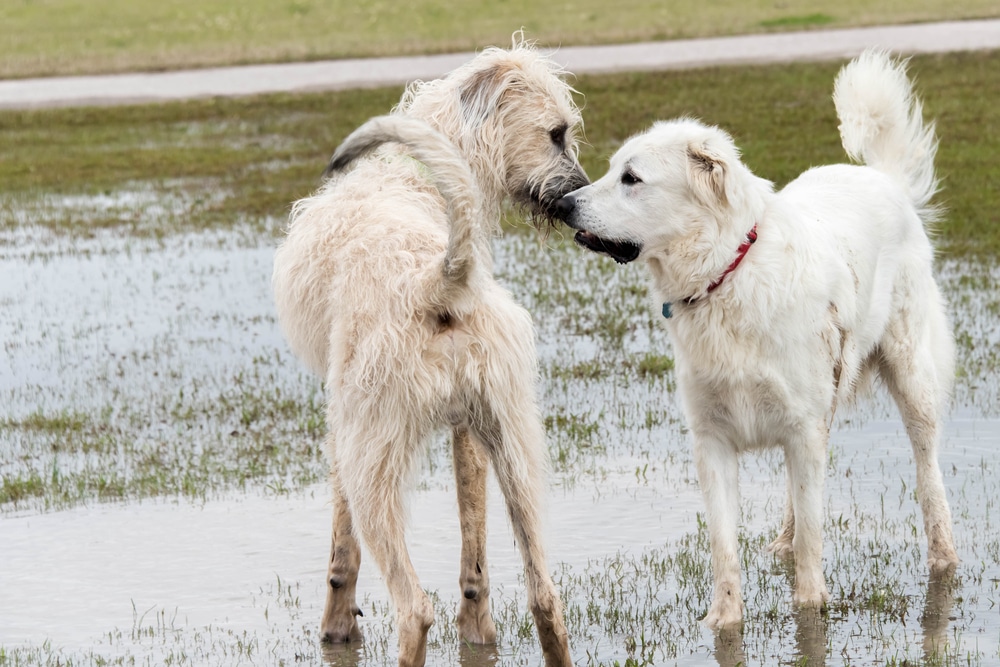
No dog is an island, and the Great Pyrenees is no exception. This gentle giant was bred to be a working dog, living and working alongside humans in the mountains of France and Spain.
Though they are independent by nature, they still crave companionship and attention from their family.
Without a canine companion, this breed may become bored and destructive. They are social creatures that need stimulation, both mental and physical.
A second dog can provide the activity and playtime that this breed needs to stay happy and healthy.
Of course, every dog is different, and some Great Pyrenees may do just fine as an only pet.
But if you’re considering adding a furry friend to your family, this breed would make a great addition.
Are Great Pyrenees Naturally Protective?
Yes, the Great Pyrenees are naturally protective. They are bred to be working dogs, and their instinct is to protect their flock.
They are gentle and loving with their family, but they will bark and even bite if they feel threatened.
“Great Pyrenees make great guard dogs because they’re always alert and on the lookout for danger.”
Are Great Pyrenees Good Emotional Support Dogs?
The Great Pyrenees is a large, gentle breed of dog that is becoming increasingly popular as an emotional support animal.
These dogs are known for their calm demeanors and deep loyalty, which makes them ideal companions for people who suffer from anxiety or depression.
“Great Pyrenees are also relatively easy to train and care for, which makes them a good choice for busy people or those who have limited experience with dogs.”
Before considering adopting this breed for emotional support, you should check that they are compatible with your lifestyle.
Great Pyrenees are large dogs that need plenty of exercise, so they may not be the best choice for those who live in small apartments or have limited mobility.
At What Age do Great Pyrenees Calm Down?
Most Great Pyrenees will start to calm down around the age of two or three years old. However, some may take longer to mature and may not reach their full potential until they are five years old or even older.
This breed is an active breed that is known for being slow to mature, so patience is key when owning this breed.
While they may settle down in terms of energy levels, the Great Pyrenees will always maintain their guarding instincts. They will continue to be loyal and protective of their family throughout their lifetime.
How to Calm a Great Pyrenees?
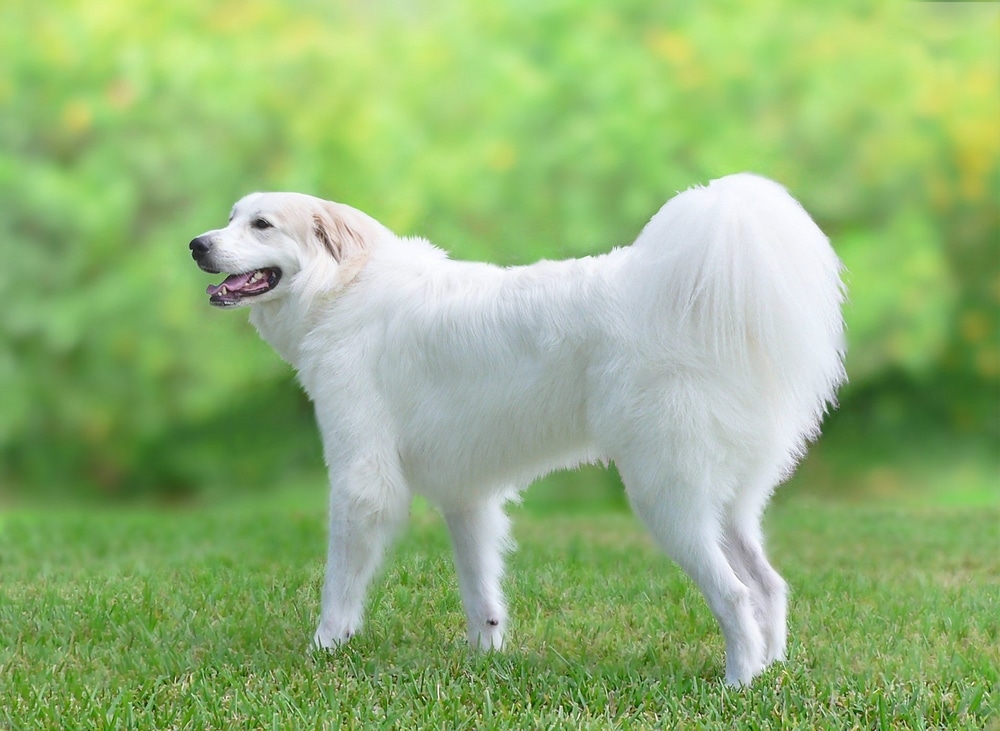
If you have a Great Pyrenees, chances are you already know that they can be very protective and territorial. While this is part of their natural instinct, it can sometimes result in them being overly aggressive or even fearful.
If you find yourself in this situation, there are a few things you can do to help calm your dog down.
First, try to remain calm. Dogs can sense when their owners are tense or nervous and this will only exacerbate the problem. If you’re feeling frazzled, take a few deep breaths and try to relax.
Next, give your dog some space. If they’re feeling overwhelmed or threatened, they may just need some time to themselves. Let them go off into another room or even outside if possible.
This will give them a chance to decompress and hopefully calm down.
Finally, try to determine what is causing your dog to feel so anxious. Is it a specific person? A specific situation? If you can figure out what’s making them uncomfortable, you will be able to better help them.
Great Pyrenees – Behavior Issues
What Reasons Does My Great Pyrenees Paw at Me?
When your Great Pyrenees leans its paw on you, it’s not just being affectionate. Though this behavior may seem like a display of love, it’s actually your dog’s way of asking for something.
There are a few different things your dog could be trying to communicate when it puts its paw on you. It could be asking for attention, food, or even just a good petting.
If you’re not sure what your dog wants, try paying attention to its body language. If its tail is wagging and it has a relaxed stance, it’s probably just looking for some love.
But if its ears are back and its body is tense, it could be hungry or feeling threatened.
The Great Pyrenees are known for being gentle giants, but they still have their own needs and wants.
What Reasons Does My Great Pyrenees Sit on Me?
Do you have a Great Pyrenees that likes to sit on you? You’re not alone! This is a common behavior for this breed, and there are a few reasons why they may do it.
For one, your Great Pyrenees sees you as part of its pack. In the wild, wolves will often sit on top of each other to show dominance within the pack. By sitting on you, your dog is claiming you as its own.
Another reason your dog may sit on you is for warmth. This breed was raised in cold climates and is used to being surrounded by snow. When they’re sitting on you, they’re essentially recreating their natural environment!
Finally, your dog may just enjoy physical contact. Dogs are social creatures and love to be close to their human companions.
Does the Great Pyrenees Chew a lot?
Generally speaking, no. Great Pyrenees are not known for being destructive chewers. However, like all dogs, they can develop bad habits and chew on things if they’re bored or anxious.
“To prevent your dog from chewing on your belongings, make sure to provide them with plenty of toys and bones to keep them occupied. You should also avoid leaving them alone for long periods of time”.
If your dog is experiencing separation anxiety or boredom, there are a number of things you can do to help them feel more comfortable and relaxed.
RELATED – Are the Great Pyrenees Chewers?
Is it Common for the Great Pyrenees to Howl?
Your Great Pyrenees may be howling for a number of reasons. They could be trying to communicate something specific, or they could just be enjoying the sound of their own voice.
Either way, it’s important to try to understand why your dog is howling so that you can better address their needs.
There are a few things that you can do to try to understand why this breed is howling.
First, take note of when they are howling and what else is going on at the time.
“If they seem to be howling in response to something outside, they may be acting as an alarm system and trying to warn you of potential danger.”
If they start howling when you leave the house, they may be suffering from separation anxiety.
How Do I Stop my Great Pyrenees from Jumping?
If you have a Great Pyrenees that loves to jump, there are a few things you can do to help stop this behavior.
First, never encourage your dog to jump by petting them or giving them attention when they do it.
Second, provide your dog with moderate exercise, so they are less likely to want to jump out of boredom.
Finally, give your dog a cue such as “sit” or “down” that they can learn to associate with not jumping. If your dog does jump, remain calm and consistent in your response, so they understand that this is not the desired behavior.
Check out the following video that provides some simple tips on how to stop this breed from jumping on people.
How Do I Stop my Pyrenees from Biting?
This breed may bite for various reasons, such as fear, territoriality, or protectiveness. However, there are several things you can do to stop your Pyrenees from biting.
One way to stop your Pyrenees from biting is to provide it with positive reinforcement when it does not bite. This means rewarding your Pyrenees with treats or verbal praise when it shows good behavior.
You should also avoid punishing your dog when it does not bite, as this could make the problem worse.
Another way to prevent your Pyrenees from biting is to socialize it from a young age. This means exposing your dog to different people and situations so that it becomes accustomed to them.
“Socialization will help reduce your dog’s fear and make it less likely to bite out of aggression.”
If you are still concerned about your dog’s aggression after trying the above, it is best to consult with a professional dog trainer to address the issues at hand.
You may also like – How to Train your Great Pyrenees to Stop Biting?
How do you Discipline a Great Pyrenees?
The Great Pyrenees are a loyal and loving breed of dog, but they can also be stubborn and strong-willed. When it comes to discipline, owners need to be firm, consistent, and fair. Here are some tips on how to effectively discipline a Great Pyrenees.
First and foremost, owners need to be consistent with their commands and expectations. If a dog is allowed to jump on the couch one day and told not to the next, it will become confused and frustrated. It’s important that owners set clear rules and stick to them.
Secondly, owners must be fair when doling out discipline. If a dog is scolded for playing too rough but never told off for chewing up a shoe, it won’t understand what they’re being disciplined for.
Finally, owners must be gentle when administering discipline. It’s important that owners never inflict physical harm or pain on a dog. This will only make them afraid and distrustful of their owner.
Great Pyrenees – Aggression Levels

Is the Great Pyrenees an Aggressive Dog?
Despite their size and reputation, this breed is quite a gentle and loving dog. Although they may seem intimidating at first, they are really just big softies at heart.
However, they can be aggressive if they feel threatened or if they are not properly socialized.
If you are thinking about getting a Great Pyrenees, it is important to do your research and make sure that you are prepared to handle a large, potentially aggressive dog.
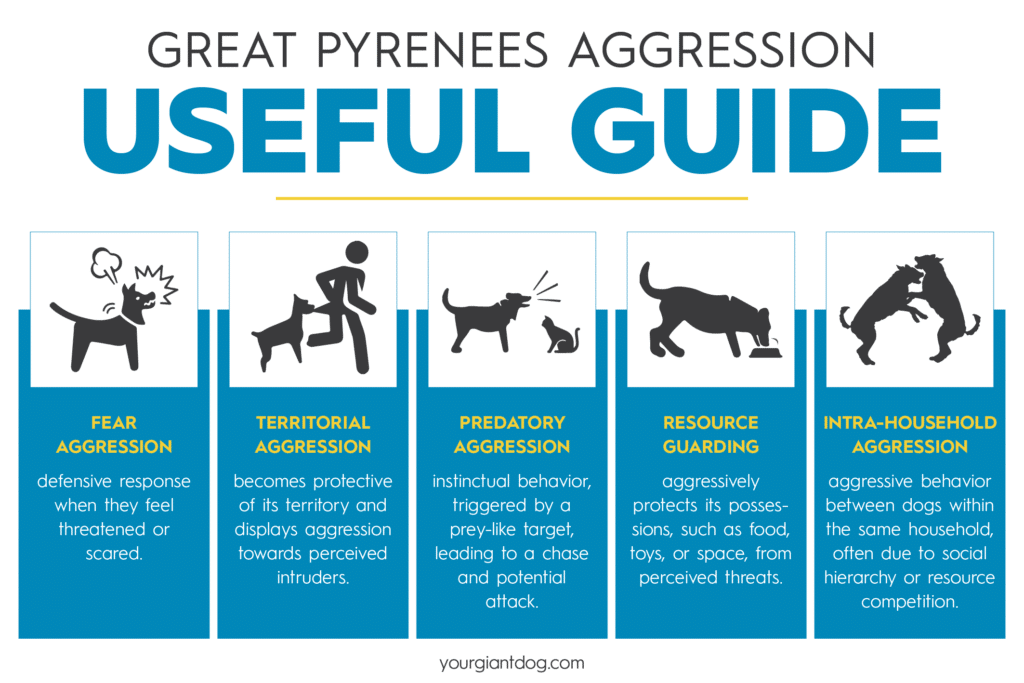
Don‘t miss – Will a Great Pyrenees Attack an Intruder?
How do I stop my Great Pyrenees from being Aggressive?
While most Great Pyrenees are gentle and loving by nature, some can be aggressive. But don’t despair! There are things you can do to stop your Great Pyrenees from being aggressive.
First, it’s important to understand why your dog may be acting aggressively. It could be fear, territoriality, or even just excitement. Once you know the root cause of the problem, you can begin to address it.
Next, start training your dog with positive reinforcement techniques. Reward your dog for good behavior and avoid using punishment as a way to train them.
With patience and consistency, you can teach your dog to behave the way you want them to.
Finally, make sure that your dog is getting enough exercise.
“Pent-up energy and lack of exercise can result in disruptive behavior, including potential aggression.”
Check out the following video that shows “Hudson” the Great Pyrenees being trained for his aggression issues:
How Dangerous are the Great Pyrenees?
The Great Pyrenees is not a dangerous breed. However, they are a large, powerful dog and should be treated with respect.
They are gentle giants who are loving and loyal to their family. But, like any dog, they need proper socialization and training to reduce the risk of problematic behaviors.
Is the Great Pyrenees Good with Strangers?
Yes, the Great Pyrenees are good with strangers. They are known to be a friendly breed, although their size can be intimidating to strangers.
They are very protective of their family and home, so they may bark at strangers who come too close. If you’re looking for a dog that will be friendly to everyone, this breed is a great choice.
How will the Great Pyrenees react to Intruders?
The Great Pyrenees is a large breed of dog that is naturally protective of its homes and families.
They were originally bred to guard sheep against predators, so their instinct is to defend their territory. If an intruder does not back down when the dog barks and growls, this breed may attack.
While most Great Pyrenees are not aggressive, any dog has the potential to bite if they feel threatened. This includes intruders that are not welcome in the family home.
It is important to socialize your dog from a young age so they know how to interact with humans and other animals peacefully.
Great Pyrenees – Strength
How Strong are the Great Pyrenees?
The Great Pyrenees is a large and powerful dog breed that is known for its strength. These dogs are often used as working dogs, and they have been known to pull sleds and carts. They are also used as guard dogs and hunting dogs.
What is the Great Pyrenees Bite Force?
The Great Pyrenees is a large, white-furred dog breed with a black nose and eyes. They were originally bred in the Pyrenees mountains of southern France to guard sheep from wolves and other predators.
Today, they are still used as working dogs on farms and ranches, but they also make great companion animals.
This breed has a very powerful bite force that can reach up to 500 psi (pounds per square inch).
This is much stronger than the average human bite, which is only about 120 psi. The strong bite force of the Great Pyrenees is mainly due to their large size and robust jaws.
Great Pyrenees – Training Needs


Is the Great Pyrenees Easy to Train?
No dog is easy to train, but some breeds are harder than others. The Great Pyrenees is one of those breeds. They’re independent and stubborn, which can make obedience training a challenge.
But with patience and persistence, you can train this breed to be a well-behaved dog.
Recommended – Are Great Pyrenees Hard to Train?
Why is the Great Pyrenees so Stubborn?
There are many reasons why Great Pyrenees can be stubborn. One reason is that they are bred to be independent. This means that they are not as willing to take direction from humans as other breeds.
Additionally, this breed is often used as a working dog, which requires them to be able to think for themselves and make decisions without human guidance.
Lastly, the Great Pyrenees are simply large dogs with a lot of personality. They can be very headstrong, and it can be difficult to get them to do what you want. However, if you are patient and consistent, you can train this breed to be obedient.
Potty Training
Is it hard to Potty Train a Great Pyrenees?
Potty training the Great Pyrenees can be tricky. The breed is notorious for being stubborn, and they tend to have a strong will of their own. But with patience and perseverance, you can successfully potty train this breed.
Here are some tips to get you started:
1. Start early. It’s best to begin potty training when your puppy is between 8-10 weeks old. If you wait too long, they may become set in their ways and harder to train.
2. Keep a consistent schedule. Feeding times, walks, and naps should all happen at around the same time each day. This will help your puppy learn when it’s time to go potty.
3. Be patient. Potty training takes time and patience.
How Long Can Great Pyrenees Hold their Bladder?
The Great Pyrenees can hold their bladder for up to eight hours at a time. This is much longer than most other breeds of dogs. The reason they can hold it for so long is that they are bred to be working dogs.
They were originally bred to be guard dogs and would spend long hours guarding their flock against predators.
While most Pyr’s will have no problem holding their bladder for eight hours, there are always exceptions to the rule. Some individual dogs may need to go out more often, especially if they are young or old.
How to stop my dog from peeing in the house?
Dogs often urinate indoors as a way to mark their territory. This can be frustrating for pet parents, but there are ways to stop this behavior.
By using positive reinforcement and consistent training, you can teach your dog to only go potty outside.
Here are some tips on how to stop your dog from peeing in the house:
1. Take your dog out frequently: A good rule of thumb is to take your dog out every two hours, especially if they’re young, old, or small. This will help them learn that they need to relieve themselves outdoors and not in your home.
2. Reward good behavior: When your dog goes potty outside, make sure to give them plenty of praise and treats.
3. Clean accidents immediately: If you find a mess, do not punish your dog. That will only make them scared of you and the area where it happened. Instead, clean up the mess right away using a pet stain and odor remover.
4. Be consistent: If you let your dog go potty inside one day and punish them another, they won’t understand what is expected of them.
Are Puppy Pads a Good Idea?
Yes, puppy pads are a good idea! Here’s why:
Puppy pads can help potty train your pup. They’re great for indoor use on rainy or cold days. Puppy pads can also be used to protect your floors from accidents.
Here are some tips for using puppy pads:
1. Place the pad in a quiet, out-of-the-way spot.
2. Put your pup on a regular potty schedule. 3–4 times per day is ideal.
3. Reward your pup when he goes potty on the pad. This will help him associate going potty with positive reinforcement.
4. Be patient! It takes time for pups to learn how to use puppy pads effectively.
Obedience Training
How to Train Your Great Pyrenees Puppy that keeps biting?
If you’ve just adopted a Great Pyrenees puppy, chances are their playful biting is already getting on your nerves.
“While it’s normal for puppies to mouth and nibble as they explore the world and their own mouths, you can train your Pyr to stop biting.”
Here are some tips for training your Great Pyrenees puppy to stop biting:
First, it’s important to understand why puppies bite. Puppies explore the world with their mouths, and they learn about people and things by putting them in their mouths.
They also use their mouths to play with other puppies. So, when your puppy bites you, it’s not because he’s being aggressive. He’s just being a puppy.
Second, don’t punish your puppy for biting. This will only make him afraid of you and more likely to bite in the future. Instead, redirect his attention to something else whenever he starts to bite. chew toys are great for this purpose.
Finally, be consistent with your training. Puppies become less confused when they are introduced to routines that they are familiar with.
Is the Great Pyrenees Obedient?
To a certain extent, yes. Great Pyrenees are intelligent dogs and can be trained to obey commands. However, they can also be stubborn and headstrong, so training may take some patience and perseverance.
Overall, Great Pyrenees are good-natured dogs that make loyal and loving companions.
With proper training and socialization, they can be well-behaved members of the family.
What Age should you start Training a Great Pyrenees?
Some experts say that puppyhood is the ideal time to start, while others believe that older dogs can be just as successful if they are given the right type of training. The most important thing is to find a method of training that works well for both you and your dog.
One of the great things about the Great Pyrenees is that they are very intelligent dogs. This means that they are able to learn new commands and tricks quite easily. However, it also means that they can be stubborn at times.
For this reason, it is important to find a training session or method that will work well for both you and your dog.
Puppyhood is often considered the best time to start training this breed.
Keeping in mind, that teaching your dog new things can happen quickly and easily by utilizing some clever online training options.
The training listed below is what we highly recommend for quick results!

Socialization
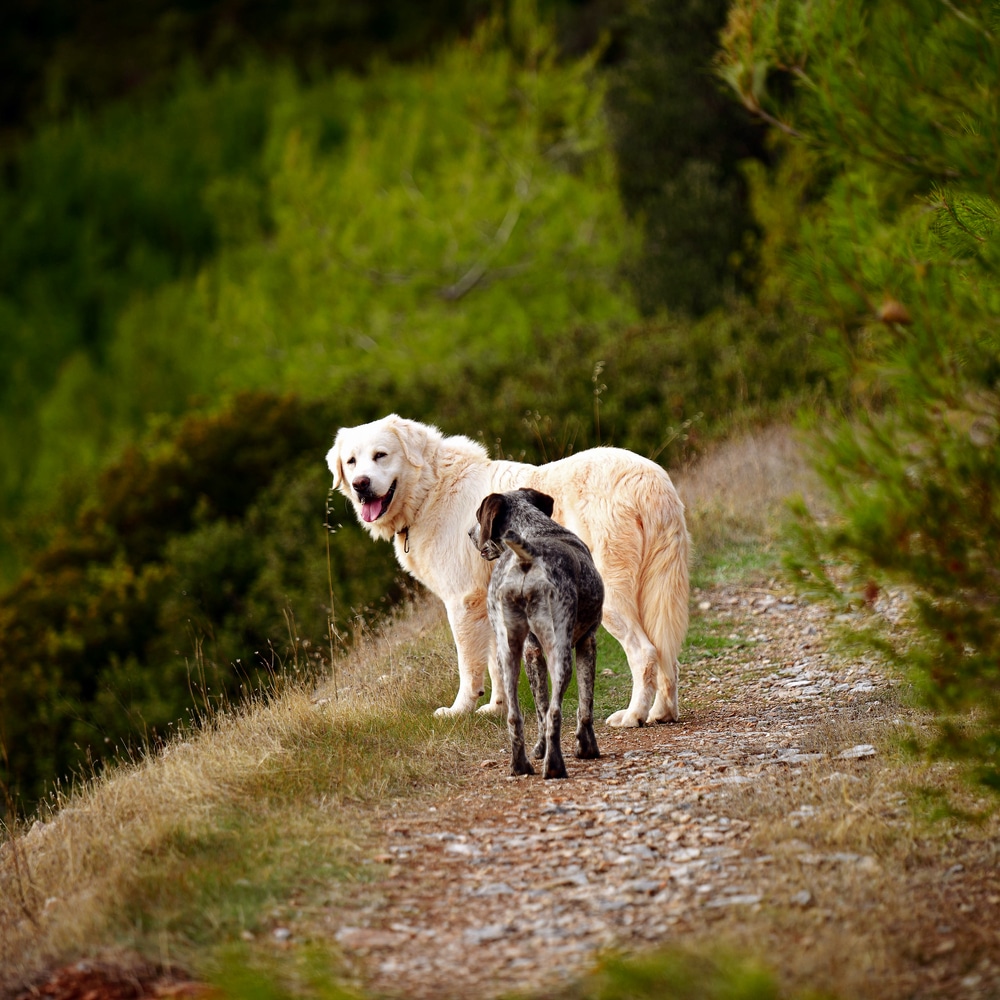
From the time a Great Pyrenees puppy is born, they are learning how to interact with other dogs and people.
“Puppies that are not properly socialized during this critical period may never learn how to interact appropriately with other dogs and people.”
As puppies grow, they continue to learn about acceptable behavior through socialization. Dogs that lack socialization may become fearful or aggressive around people and other animals.
How do you socialize the Great Pyrenees?
The Great Pyrenees is a gentle giant but socializing them can be difficult since they are so large.
Here are some tips on socializing your Great Pyrenees:
1. Start socialization early. The earlier you start, the better. It will be easier to introduce your dog to new people and experiences when they are younger.
2. Take things slowly. Don’t try to force your dog into situations that make them uncomfortable. Introduce them to new people and experiences gradually and let them approach at their own pace.
3. Be patient. Socialization can be a long process, especially with a large breed like the Great Pyrenees. Don’t get discouraged if it takes longer than you expected, just keep working at it patiently and consistently.
Don’t miss – Are Great Pyrenees Good with other Dogs?
Can the Great Pyrenees be Off Leash?
No dog breed is 100% safe to be off-leash, but some breeds are much better at staying close by your side than others. The Great Pyrenees is one of those breeds.
This gentle giant was bred to work alongside humans, guarding flocks of sheep in the mountains of France and Spain. They were bred to be loyal and protective, and they excel at both of those traits.
Their size alone makes them good candidates for being off-leash. At 100-130 pounds, they’re not easy to lose track of! But their temperament is what really makes them shine in this department.
This breed is patient, and good-natured – perfect for hikes and walks in the park where they can explore and sniff to their heart’s content.
Great Pyrenees – Exercise Needs

What are the Exercise Needs of the Great Pyrenees?
Great Pyrenees are very strong dogs and need plenty of exercise to stay fit and healthy. A daily walk is a good start, but they will also enjoy playing fetch or going for a run.
“If you don’t have time for a long walk or play session every day, two shorter walks or one longer walk will do.”
While Great Pyrenees are mostly gentle giants, they can become bored and destructive if they don’t get enough exercise. You should be aiming for around 1 hour of consistent exercise every day to keep them happy and healthy.
You may also like – How much exercise do Great Pyrenees Need?
Are the Great Pyrenees Fast Runners?
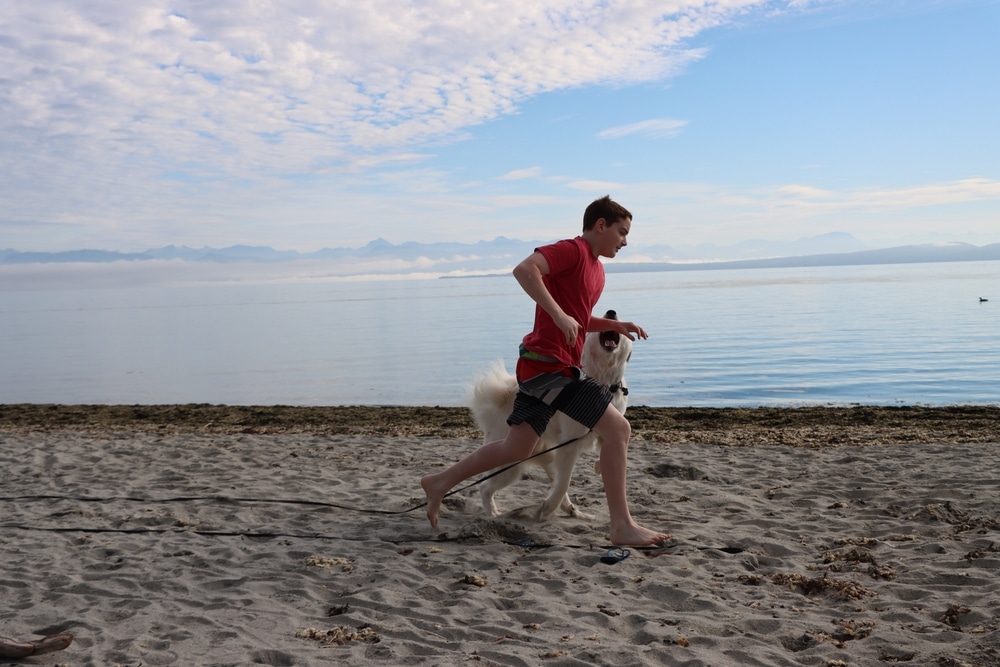
Although the Great Pyrenees is not known as a particularly fast dog breed, they are actually quite speedy when they need to be. On average, they can run up to 25 miles per hour.
However, they are more likely to maintain a slower pace of around five to eight miles per hour during regular running or walking.
“The Great Pyrenees is not built for long-distance running, but their short bursts of speed can be helpful in many situations.”
For example, if they need to escape from a dangerous situation or chase after prey, their speed can come in handy.
Additionally, their speed can be helpful when herding livestock since they need to be able to keep up with the animals.
Is the Great Pyrenees Good at Hiking?
Yes, Great Pyrenees are good hiking dogs! They are large enough to carry their own supplies, and their thick fur coats protect them from the elements.
They are also very loyal and will stick by your side no matter what. However, they do have some disadvantages to hiking.
For example, their feet will get tired if they hike in rough terrain for too long. Their large size can also be a problem when hiking in tight spaces since they could knock over trees, rocks, and other hikers.
Can Great Pyrenees Swim?
Many Great Pyrenees can swim although they will generally find it challenging. This is because they are a land-based breed, and their center of gravity is higher than that of water-based breeds.
Additionally, their fur is dense and heavy, which makes it difficult for them to stay afloat.
However, this doesn’t mean they can’t enjoy a dip in the water on a hot day. With a little help from their human friends, this breed can safely enjoy a swim.
If you’re thinking about taking this breed for a swim, there are a few things you should keep in mind.
First, make sure the water is shallow enough for them to stand in. They should never be more than waist-deep in water.
Second, don’t let them swim too far from the shore. It’s important to be able to quickly reach them if they start to struggle.
Finally, have a towel handy to dry them off when they’re done swimming.
However, with some patience and practice, most Great Pyrenees will eventually learn to enjoy swimming.
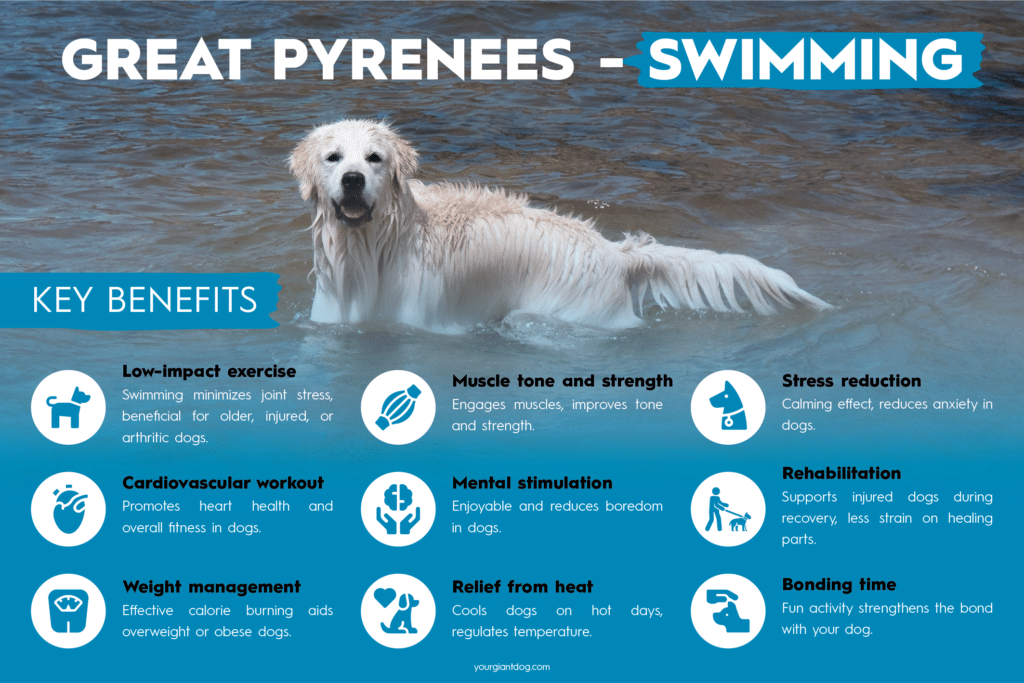
Does a Great Pyrenees Need Much Space?
“A common misconception about the Great Pyrenees is that they need a lot of space to run around and be happy. However, this isn’t necessarily true. While they do enjoy having a backyard to roam in, they don’t require a lot of space to be content.”
As long as they have plenty of room to stretch out inside the house and a few toys to keep them amused, they’ll be just fine. Daily walks will also help if you have a small yard at home.
So, if you’re thinking about getting a Great Pyrenees but are worried about not having enough space for them, don’t be!
Great Pyrenees – Mental Stimulation
Is the Great Pyrenees Intelligent?
While there’s no easy way to test canine intelligence, experts believe that the Great Pyrenees are a moderately smart breed.
They’re quick learners and have a good memory, which makes them excellent candidates for training. Whether it’s learning tricks or simple commands, this breed is up for the challenge.
“But it’s not just their ability to learn that makes them intelligent. The Great Pyrenees is also known for their problem-solving skills.”
Don’t miss – How Smart are Great Pyrenees?
What Kind of Toys do Great Pyrenees Like?
There are a few things to keep in mind when considering what kind of toys the Great Pyrenees like.
For one, these dogs are intelligent and need stimulation and brain training in the form of brain games and food puzzles.
Secondly, they’re strong chewers, so you’ll want to get them toys that can stand up to their jaws, like the KONG Extreme line.
Ultimately, this breed loves anything that they can chew on, such as bones or rope toys.
As they have a rather strong bite force, it is worthwhile buying dog toys that are fairly durable and won’t break after an hour of play.
Great Pyrenees – Grooming Requirements

How Often Should a Great Pyrenees be Bathed?
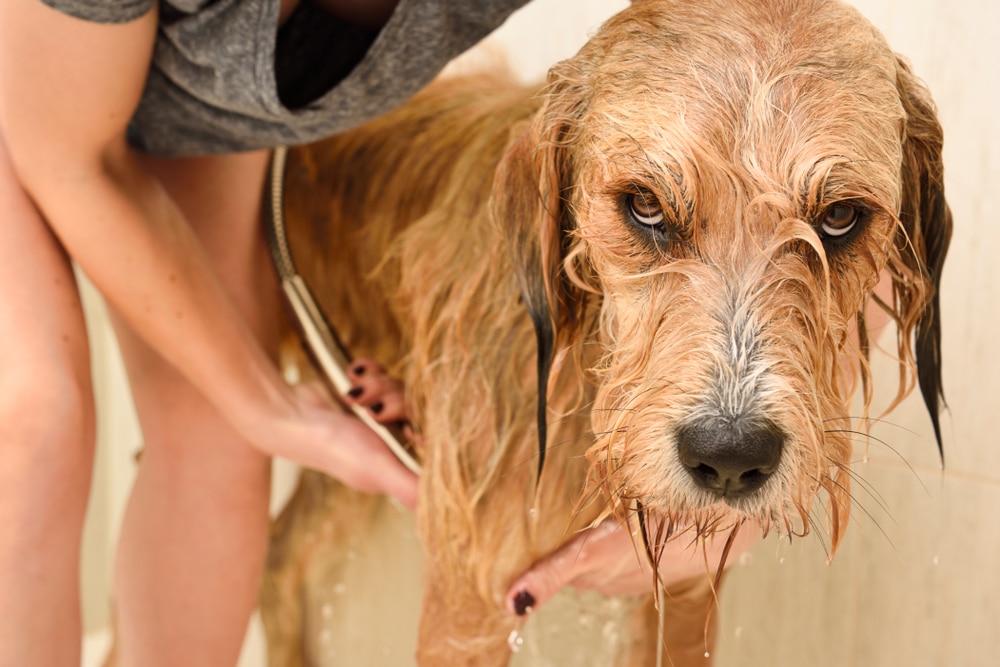
This breed should be bathed about every three months. However, if your dog gets dirty more often, he may need to be bathed more frequently.
You should also consider how often your dog goes outside and whether he enjoys being in the water.
“If you bathe your dog too often, his skin may become dry and irritated.”
How to Groom a Great Pyrenees in preparation for Summer?
The Great Pyrenees is a majestic dog breed that is well-known for its thick, white coat. While this coat provides great protection against the cold winter weather, it can be quite problematic during the summer months.
Here are some tips on how to groom this breed for summer:
1. Start by brushing your dog’s coat thoroughly. This will help to remove any dead hair and make the coat more manageable.
2. Next, use Clippers with a No. 40 blade to trim the hair around your dog’s feet and legs. Be careful not to clip too close to the skin.
3. You may want to consider giving your dog a “summer cut.” This involves shaving the hair on the dog’s back and sides down to about one inch in length.
Consult with a professional groomer before doing this yourself.
Are the Great Pyrenees Big Shedders?
This breed is known for its thick, protective coat that keeps them warm in the coldest conditions. But all that fur means they’re also one of the heaviest-shedding breeds. So just how much do the Great Pyrenees shed?
Most Great Pyrenees will shed a moderate amount throughout the year, with heavier shedding during the spring and fall months when they’re blowing out their winter coat.
Some individuals may shed more heavily than others, but overall, you can expect your Great Pyrenees to lose a lot of fur.
Regular brushing is key to minimizing shedding and keeping your dog’s coat healthy. Be sure to use a de-shedding tool or brush designed specifically for dogs with double coats.
And if shedding is really becoming a problem, talk to your vet about possible solutions, like changing your dog’s diet or using supplements.
RELATED – How much do Great Pyrenees Shed?
What kind of Brush do you use on a Great Pyrenees?
There are a variety of brushes available to use on the Great Pyrenees, but which one is best? The most important factor to consider is the dog’s coat type.
This breed has two types of coats: the outer coat, which is long and coarse, and the undercoat, which is soft and dense. If you’re not sure which brush to use, ask your groomer or veterinarian for help.
The outer coat should be brushed with a wide-toothed comb to avoid matting and tangles. Start at the head and work your way down the body, taking care to avoid sensitive areas like the belly.
For the undercoat, use a slicker brush or a shedding blade. These tools will help remove loose hair from the undercoat without damaging it.
RECOMMENDED – Are Great Pyrenees Hypoallergenic? (9 Key Facts!)
What Can a Great Pyrenees Eat?

What Type of Food Should a Great Pyrenees Puppy Eat?
A Great Pyrenees puppy should eat food that is high in protein and fat. Puppies need a lot of energy to grow, so their food should be nutritious and filling.
Puppy food should also be easy to digest so that the puppy’s stomach doesn’t get upset.
“Puppies are notorious for being picky eaters. They may not like the food you first give them, so it’s important to be patient and try different types of food until you find one that they like”.
Be sure to consult with your veterinarian before changing your puppy’s diet.
How Much Does a Great Pyrenees Eat?
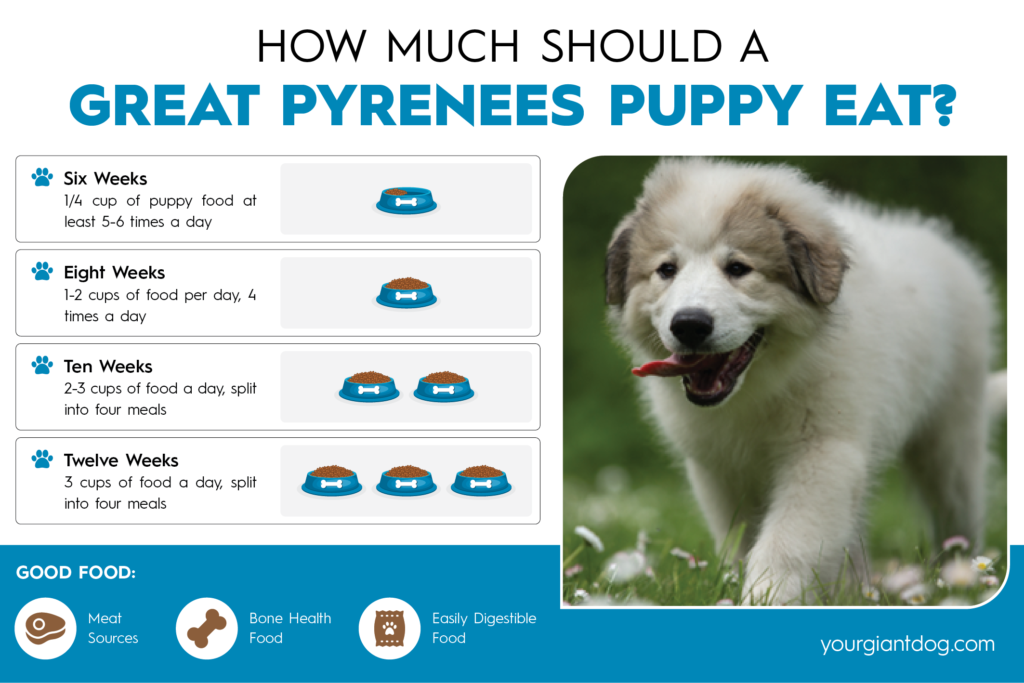
A fully grown Great Pyrenees will typically eat about 4 to 6 cups of food per day, depending on their age, activity level, and weight. However, some may eat up to 12 cups per day.
Puppies and young dogs tend to eat in line with the quantities showcased above.
Active dogs may need more food than those that are less active. Dogs that weigh more will usually need more food than smaller dogs.
If you are unsure how much to feed this breed, talk to your veterinarian or a dog nutritionist.
Do the Great Pyrenees need a Special Diet?
No, Great Pyrenees do not need a special diet. In fact, they can do well on almost any type of commercial dog food that is nutritionally balanced and appropriate for their size.
However, some owners prefer to feed their Pyrs a raw diet or a homemade cooked diet.
If you choose to do this, make sure to work with a veterinary nutritionist to ensure that your dog is getting all the nutrients he or she needs.
Can the Great Pyrenees Eat Raw Food?
A raw food diet is becoming increasingly popular for humans and their canine companions.
Many people believe that a raw diet is closer to what dogs would eat in the wild and can provide them with more nutrients than a kibble diet. But can Great Pyrenees really benefit from eating raw food?
There are pros and cons to feeding this breed a raw diet. On the plus side, raw diets can be nutritionally dense and can help your dog to maintain a healthy weight.
“Raw diets can also be helpful for dogs with allergies or sensitivities to certain ingredients. They can also be beneficial in promoting shinier coats, healthier skin, and greater energy levels.”
However, there are some drawbacks to feeding your dog a raw diet as well. For example, raw diets can be hard to digest for older dogs and can contribute to health problems for them.
This can include potential bacteria in the meat, along with bones causing safety concerns with choking, etc.
Can a Great Pyrenees Eat Table Scraps?
Yes, Great Pyrenees can eat table scraps, but only certain types. Table scraps that are high in fat, sugar, or salt should be avoided.
Instead, opt for leaner meats, vegetables, and fruits. When feeding this breed table scraps, always do so in moderation to avoid upsetting their stomachs.
Can a Great Pyrenees Eat Dog Treats?
Yes, the Great Pyrenees can eat dog treats. However, it is essential to check with your veterinarian first to make sure the treat is safe for your dog.
Some treats may be too high in fat or calories for your dog, so it is important to choose wisely.
If you are looking for a treat that is safe and healthy for this breed, consider homemade dog treats.
There are many recipes available online that use healthy ingredients such as fruits, vegetables, and whole grains. Apples, blueberries, strawberries and watermelon are all great options for snacks.
You can also find many organic and natural dog treats at your local pet store.
Which Supplements are Good for Great Pyrenees?
When it comes to Great Pyrenees, there are a few supplements that can be really helpful.
Fish oil is a great supplement for Great Pyrenees. It can help keep their coat healthy and shiny. It can also help with joint health.
Glucosamine is another great supplement for this breed. It can help with joint health and mobility. It can also help with digestion.
Omega-3 fatty acids are also good for this breed. They can help with coat health, skin health, and joint health.
Is the Great Pyrenees Dog Friendly?
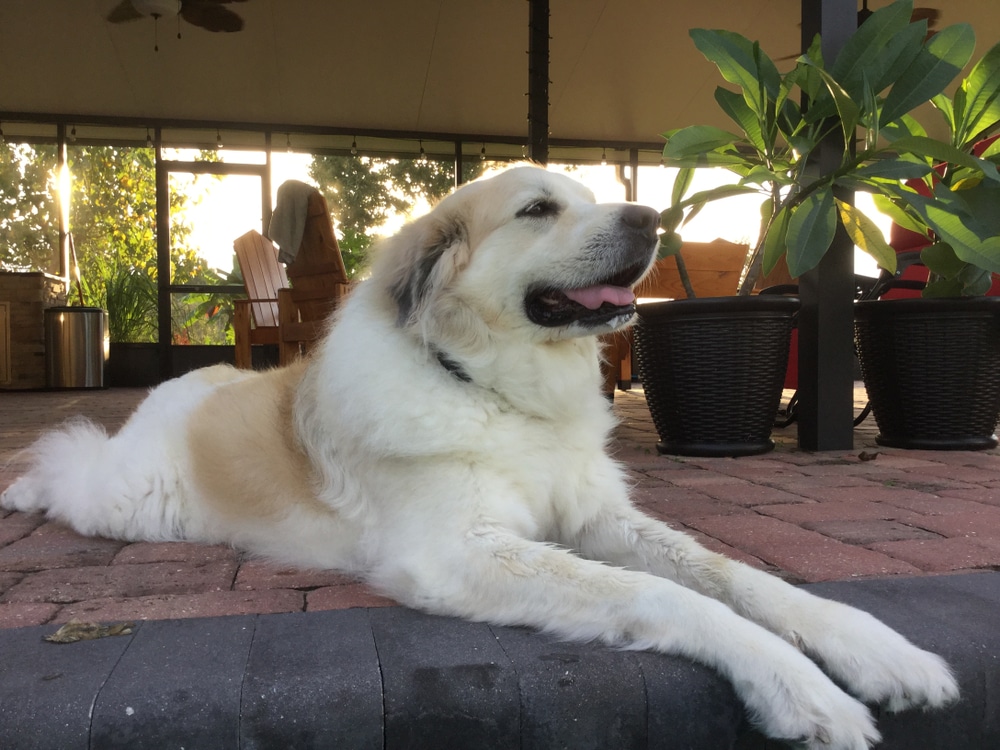
Yes, the Great Pyrenees is a dog-friendly breed. They are typically quite gentle and loving dogs that make great family pets.
They are also good with other animals, including most other dogs. However, they can be shy around strangers, so it is important to socialize them from a young age.
Do the Great Pyrenees have same-sex aggression?
No two Great Pyrenees are the same, but many of them share a trait that can be problematic: same-sex aggression.
This can manifest itself in several ways, from growling and snapping to outright fighting. It’s essential to understand this behavior so you can manage it effectively.
There are several reasons why this breed may become aggressive toward other dogs of the same sex.
In some cases, it’s simply a matter of dominance; the dog wants to be the top dog and is willing to fight to assert his position.
Other times, it may be a case of hormone imbalance. Aggression can occur while a female Great Pyrenees is on heat; however, unneutered males are particularly prone to this problem.
Finally, some dogs become aggressive due to fear or insecurity; they may have had bad experiences with other dogs in the past or lack socialization.
Are the Great Pyrenees good with Small Dogs?
Yes, Great Pyrenees are good with small dogs. They are gentle and patient by nature, making them great companions for smaller breeds.
Additionally, their calm demeanor can help to provide a sense of security for a small dog who may be easily startled.
This breed is also a reliable guardian, so having one around can help to keep a small dog safe from any potential threats.
Are the Great Pyrenees good with Large Dogs?
Yes, Great Pyrenees are also good with large dogs and are gentle giants that love everybody,
Known for their patience and tolerance, they make great playmates for larger dogs that may be a little hyperactive.
This breed is also fiercely protective of its family and will stand up to any dog (regardless of its size) that threatens them or its pack.
How do you Introduce a new dog to a Great Pyrenees?
Here are a few tips on how to introduce a new dog to a Great Pyrenees:
1. Choose a neutral location like a park for the first meeting. This will help the dogs feel more comfortable since they’re not on either dog’s home turf.
2. Let the dogs sniff each other before doing anything else. This is how they’ll get to know each other and figure out if they want to be friends or not.
3. If both dogs seem interested in each other, start with short walks together while keeping them on leashes.
4. Once they seem comfortable with each other, let them run around the park together. It’s essential that you’re there for this step so that you can break up any fights before things get serious.
5. If you’re still feeling nervous about them being together, keep the dog play separate from your walks.
6. Now that they’re comfortable with each other, they can start spending time together without a leash as long as you are there to supervise.
Is the Great Pyrenees Friendly around Kids?

The Great Pyrenees is a gentle giant, and despite their size, they are typically quite friendly and gentle around kids.
They are patient, loving, and protective, making them the perfect family dog.
However, because of their size, it is important to socialize them around children from a young age so that they know how to be gentle.
Is the Great Pyrenees Safe with Kids?
Yes, Great Pyrenees are generally safe with kids. However, there are a few things you should keep in mind if you have small children and a Great Pyrenees.
First, this breed is a large dog and can unintentionally knock over small children.
Second, they are protective by nature and may bark or even lunge at strangers who come too close to your children.
Finally, they have a lot of fur and shed frequently, which can be overwhelming for some children.
If you take these things into consideration, then you and your children will be able to enjoy each other’s company safely.
Is the Great Pyrenees Safe around Babies?
Although Great Pyrenees are gentle and loving by nature, they are still large dogs. Because of their size, it is essential to take some precautions when introducing them to small children, especially babies.
“The best way to introduce a Great Pyrenees to a baby is to let the dog sniff the baby while the baby is being held by an adult.”
This will help the dog get used to the scent of the child. It is also important to never leave a baby unattended with this breed, even if the dog is well-trained.
Overall, as long as some basic safety precautions are taken, this breed can make wonderful companions for families with small children.
Check out the following video compilation which shows how friendly the Great Pyrenees are around babies.
Great Pyrenees – Drooling Levels
Why does my Great Pyrenees slobber so much?
There are many reasons why your Great Pyrenees might slobber, but the most common reason is that they are excited.
Excitement causes their adrenal glands to release a hormone called cortisol, which makes their salivary glands produce more saliva.
This breed has very large teeth and tongues, which can contribute to their drooling. Another possible reason for your dog’s slobbering is that they are trying to cool off.
Dogs don’t sweat like humans do, so they pant and drool to evaporate moisture from their bodies and help regulate their body temperature.
“If your dog is constantly drooling and you’re concerned, it’s best to consult your veterinarian to rule out any health problems.”
How to prevent your Great Pyrenees from Drooling?
The Great Pyrenees is a gentle giant of a dog, known for its even temperament and loyalty. But they are also known for their drooling – which can be quite a nuisance.
If you’re tired of constantly cleaning up your dog’s drool, there are some things you can do to prevent it.
First, try to keep your dog’s mouth clean by brushing its teeth regularly. This will help to remove any build-up of saliva that could cause them to drool. You can also try feeding your dog foods that are easier to chew, such as cooked chicken or rice.
Finally, if all else fails, there are special anti-drooling neckbands that you can buy that will absorb your dog’s saliva before it has a chance to escape its mouth.
Great Pyrenees – Barking Levels

Why does the Great Pyrenees Bark a lot?
There are a number of reasons why the Great Pyrenees barks a lot. One reason is that they are bred as working dogs and barking is part of their job description.
They are also natural guardians and will bark to alert their owners to any potential threats.
Finally, this breed is a social animal and enjoys the company of its human families. They may bark out of boredom or loneliness if they feel left out or isolated.
Can you teach the Great Pyrenees not to bark?
It is extremely difficult to stop your Great Pyrenees from barking. If anything, barking on occasion is a healthy thing and lets you know your dog is trying to get your attention or something is potentially wrong.
Regardless, there are some things you can do if their barking is becoming excessive.
The first step is to identify when your dog is barking and what is causing the barking. Once you know what triggers the barking, you can begin to work on teaching your dog to be quiet.
This may include using positive reinforcement such as treats or praise when your dog is quiet, or using negative reinforcement such as ignoring your dog or moving away from him when he starts to bark.
It is important to be consistent with your commands and rewards so that your dog knows what behaviors are expected of him.
Great Pyrenees – Weather Tolerance
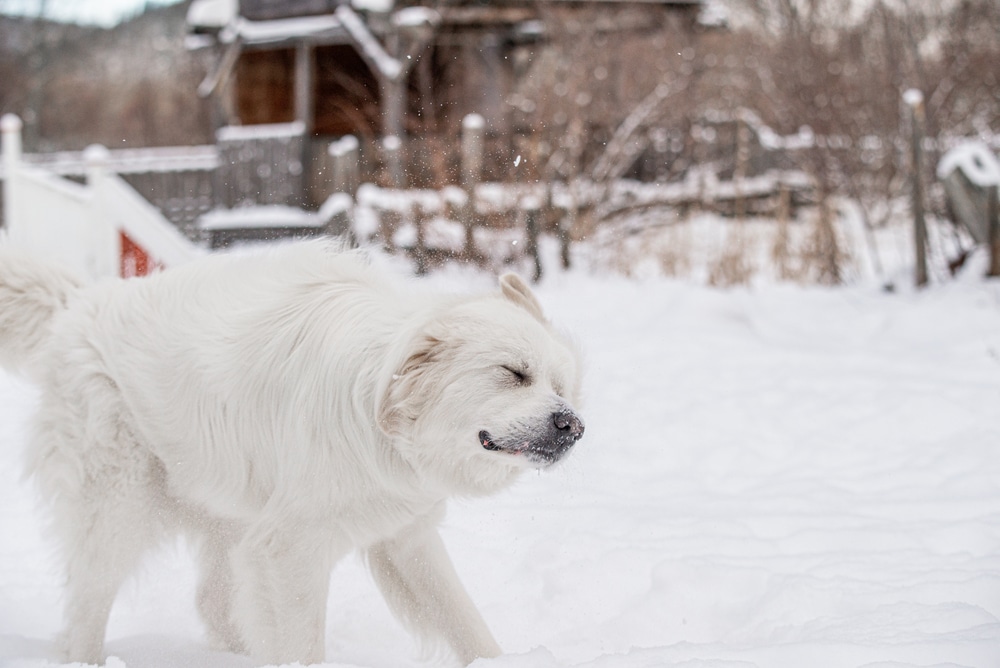
Are Great Pyrenees Good in Extreme Temperatures?
Hot Weather
As the summer heat wave hits much of the country, pet parents may wonder if their Great Pyrenees Breed can handle the extreme heat.
While these dogs are built for cold weather, they can actually do quite well in hot weather too, as long as certain precautions are taken.
For one, this breed needs access to plenty of fresh water and shade. They should also be given a light diet during the summer months to avoid putting too much strain on their digestive system.
Finally, it’s important to avoid strenuous exercise with this breed in extreme heat – stick to walks in cooler morning or evening hours instead.
With a little care, this breed can enjoy a comfortable summer just like the rest of the family.
Don’t miss – Are Great Pyrenees Good in Hot Weather?
Cold Weather
As the weather gets colder, many people wonder if their Great Pyrenees Breed will be able to handle the extreme temperatures.
While these dogs are bred in cold climates and have a thick coat of fur, you should keep a few things in mind when it comes to keeping this breed comfortable in the winter.
First, make sure your dog has access to shelter from the elements. This can be in the form of a doghouse, garage, or even just a covered porch.
“If your dog is going to be outside for extended periods of time, make sure they have a dry and warm place to rest.”
Second, give your dog plenty of food and water. In cold weather, dogs burn more calories trying to keep warm so it’s important to make sure they’re getting enough nutrition.
Lastly, make sure your dog is well-groomed. This will help them stay comfortable in the winter and prevent frostbite on their paws.
How Long can Great Pyrenees stay in the Snow?
Great Pyrenees Breed is built for cold weather and loves spending time in the snow. They have a thick double coat of fur that helps protect them from the cold.
However, the Great Pyrenees Breed should not stay in the snow for more than an hour or two at a time. After an hour or two, their fur will start to get wet, and they will begin to feel cold.
If you must leave your Great Pyrenees in the snow for more extended periods, make sure to provide them with a warm, dry place to rest.
Can the Great Pyrenees be left Outside?
Many dog owners choose to leave their outside for most of the day. However, there are some things to consider before making this decision.
This breed is known as a huge dog, requiring a lot of space to run and play. They may become bored and destructive if you do not have a large yard for them to roam in.
Additionally, they are bred in cold climates and have a thick coat of fur that helps protect them from the cold weather.
If you live in an area with extreme weather conditions, it is important to provide your dog with a shelter that will protect them from the elements.
The shelter should be large enough for them to stand up and turn around and should be raised off the ground so that it stays dry inside.
Are the Great Pyrenees Good Inside Dogs?
Yes, Great Pyrenees can make good inside dogs, given the right circumstances. They are a large breed, so they need plenty of space to move around and opportunities for exercise.
They also have a thick coat that needs to be brushed regularly.
“If you can provide them with a large enough space and are willing to brush their coat often, they can be happy living inside with you.”
Does the Great Pyrenees Breed have Health Problems?

Yes, the Great Pyrenees do have health problems. The most common health problems seen in this breed are Canine Hip Dysplasia (CHD), Patellar Luxation, Gastric Torsion, Entropion, and Cancer.
Canine Hip Dysplasia
CHD is a condition that affects the hip joint and is the most common skeletal disorder seen in dogs.
The severity of CHD can vary from dog to dog, but it can eventually lead to arthritis and pain.
Patellar Luxation
Patellar luxation is a condition that affects the kneecap and can cause lameness in the affected leg.
Gastric Torsion
Gastric torsion, or bloat, is a life-threatening condition that occurs when the stomach twists on itself, cutting off the blood supply and causing potentially fatal damage.
Entropion
Entropion is a condition where the eyelid rolls inward, causing irritation to the eye.
Cancer
Cancer is a serious disease that can lead to blindness and death.
Lymphoma, or cancer of the lymph nodes, is a rapidly growing cancer that can spread to other parts of the body.
What is the Lifespan of the Great Pyrenees?
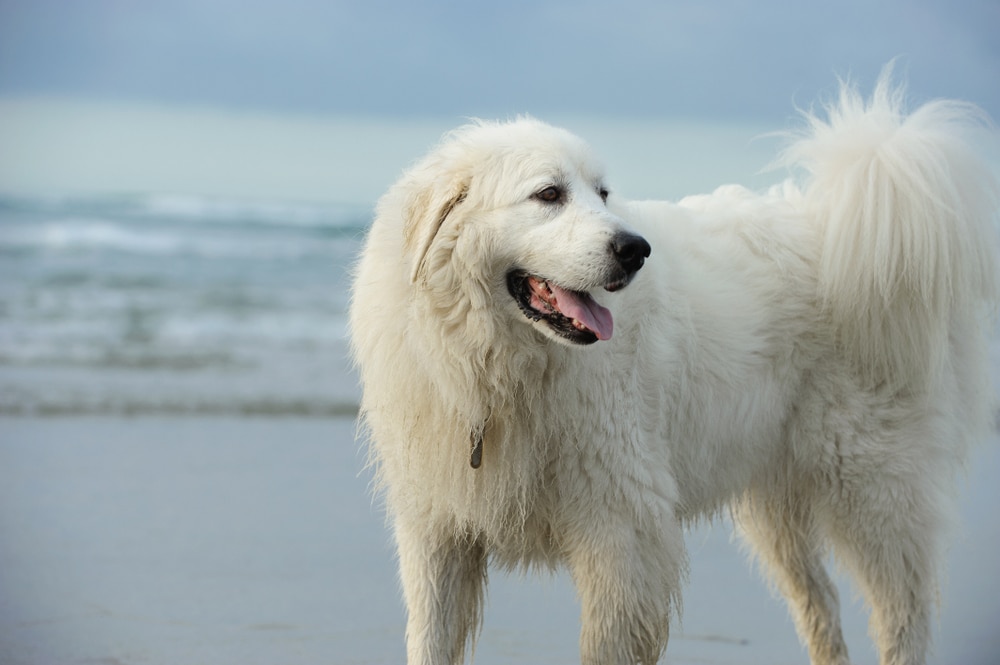
The average lifespan of a Great Pyrenees Breed is 10-12 years. However, some have been known to live as long as 15 years. The breed is generally healthy, but some health problems can affect them as listed previously.
To maximize the life expectancy of this breed, be sure to provide them with a good diet, regular physical and mental exercise, and regular checkups with the Veterinarian.
RELATED – How Old do Great Pyrenees Live?
Great Pyrenees Breed – Puppy Prices

What is the average price of a Great Pyrenees?
The average price of a Great Pyrenees from a reputable breeder is typically between $1,000 and $2,500.
Puppies typically cost more than adult dogs, and prices can vary based on the breeder, their location, and the dog’s individual needs.
Some Great Pyrenees may need special care or training, which can also affect the price.
Why are so many Great Pyrenees Abandoned?
There are several reasons why the Great Pyrenees Breed is abandoned.
One reason is that they require a lot of exercise and space. They also have a strong prey drive and can be difficult to train.
Another reason is that they are expensive to purchase and maintain.
Finally, they have a reputation for being aggressive at times, which can make them difficult to place in homes.
Why are there so many Great Pyrenees Breed in Shelters?
There are several reasons why the Great Pyrenees Breed find themselves in shelters.
One reason is that they are often bought on a whim by people who are not prepared to handle a dog of their size and energy level.
Once the novelty of having a big, fluffy dog wears off, many people realize they are not equipped to provide the daily exercise and mental stimulation a Pyr needs, and they end up surrendering them to shelters.
Another reason is that Pyrs can be challenging to train and live with; they are independent thinkers and have a strong sense of duty to their family or flock, which can result in guarding behaviors that some people find undesirable.
Because they were bred to work independently in remote areas, they can also be aloof and suspicious of strangers, which, again is not always what people are looking for in a family pet.
This is why it’s important to research and ask the right questions before choosing a breed. Your choice needs to factor in your lifestyle and the expectations you have from dog ownership.
Where to Buy a Great Pyrenees?
There are a few things to consider when purchasing a Great Pyrenees. First, decide whether you want a purebred or mixed breed.
Second, think about where you will purchase the dog. Will you go through a breeder, rescue organization, or pet store?
If you want purebred Great Pyrenees, your best bet is to find a reputable and responsible breeder. Do some research to find a breeder who has experience and knowledge about the breed.
The following is a Great Pyrenees Breeders list, as recommended by the Great Pyrenees Club of America:
CLICK HERE: LIST OF RECOMMENDED GREAT PYRENEES BREEDERS – USA
Be prepared to pay more for a purebred dog than you would for a mixed breed.
If you are interested in adopting a Great Pyrenees, there are many organizations that focus on rescuing and rehoming Pyrs.
“Adopting from a rescue is often cheaper than buying from a breeder or pet store, and you may have the option to adopt an older dog.”
If you want to buy the Great Pyrenees Breed from a pet store, make sure it is a reputable store. Reputable stores will have the dog examined by a veterinarian and guarantee that the dog is healthy.
Are Great Pyrenees Breed Suitable Pets?
Are the Great Pyrenees good for first-time owners?
The Great Pyrenees Breed is a gentle giant of a dog, and while they may seem intimidating at first, they are actually one of the best breeds for first-time owners. Here are a few reasons why:
First, Great Pyrenees are known for being very patient and good with children. They are also very protective of their family and home, which can be a great asset for first-time owners who may not be used to having a dog around.
Another reason Great Pyrenees Breeds make great first-time dogs is that they are relatively easy to train.
They are intelligent dogs who want to please their owners, so with some patience and consistency, most owners should be able to teach their dogs basic commands such as sit, stay, and come.
You may also be interested in – Are Great Pyrenees Good Pets?
Should I Get a Male or Female Great Pyrenees?
When deciding whether to get a male or female Great Pyrenees, there are a few things to consider.
“Size, energy level, and grooming needs are all important factors in making your decision.”
Males typically weigh between 100-120 pounds, while females tend to be slightly smaller at 80-100 pounds. If you’re looking for a big dog, then a male Great Pyrenees Breed is probably the way to go.
They also tend to have more energy than their female counterparts and require more exercise. However, this doesn’t mean that they’re hyperactive – they’re very calm, gentle giants.
Females are often considered the better choice when it comes to temperament. They tend to be less aggressive and more loving than males.
They’re also usually easier to train since they have shorter attention spans.
Whichever gender you choose, it’s best to be mindful that the potential traits of your dog are suitable for your lifestyle.
Is the Great Pyrenees Breed Right for Me?
The Great Pyrenees is a great dog for those who are looking for a loyal and loving companion. They are also protective of their family and make great watchdogs.
If you are thinking of getting a Great Pyrenees Breed, be sure to do your research and ask lots of questions to make sure they are the right fit for you and your family.
Great Pyrenees Rescue Organizations
Rescue organizations for the Great Pyrenees provide a huge number of benefits for both the dogs and their potential owners. We’ve listed these below:
| Rescue and Rehoming | These organizations work to rescue and rehome Great Pyrenees dogs in need. This can include taking in dogs from shelters or abusive or neglectful situations, as well as helping to rehome dogs whose owners can no longer care for them. |
| Adoption Process | This involves filling out an application, a home visit, and a reference check. Some organizations may also require an adoption fee and may have additional requirements such as a fenced yard or experience with large-breed dogs. |
| Resources and Support | This includes information on the breed, training, and care advice, and access to a community of other Great Pyrenees owners and enthusiasts. |
| Advocacy and Education | This includes promoting responsible ownership and care for the breed, as well as working to address issues such as overbreeding and neglect. |
The following provides potential owners of the Great Pyrenees with a list of options from reputable rescue organizations across the US:
| Organization | Location | Contact Info |
| National Great Pyrenees Rescue | Nationwide | https://www.nationalpyr.org/ |
| Great Pyrenees Rescue of Atlanta | Georgia | https://www.greatpyratlanta.com/ |
Final Thoughts
The Great Pyrenees is clearly an extraordinary breed with a rich history and remarkable qualities.
This ultimate guide aims to provide valuable insights and information for anyone considering adding a Great Pyrenees to their family or who simply admires these magnificent dogs.
With proper care and love, a Great Pyrenees can be a loyal and devoted companion for many years to come.

